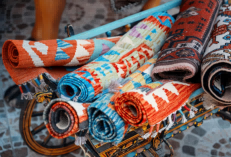 Import News
Import News
 21-07-2023
21-07-2023
Rug importers play a crucial role in the global market, facilitating the trade of diverse and culturally significant rugs from various regions, including Africa. African rugs are known for their vibrant colors, unique designs, and skilled craftsmanship, making them sought after by consumers worldwide. In this article, Tendata will explore the types of rugs that rug importers specialize in importing from Africa, shedding light on their cultural significance, market demand, and appeal to consumers.

Traditional Handwoven Rugs: A Heritage of Craftsmanship
Traditional handwoven rugs hold immense cultural value as they reflect the heritage and craftsmanship of African communities. Rug importers often specialize in sourcing rugs made using age-old techniques, passed down through generations. These rugs feature intricate patterns and symbols that tell stories of the local culture, history, and beliefs. Importers recognize the market demand for these authentic pieces that add a touch of tradition and history to homes worldwide.
Berber Rugs: Timeless Beauty of North Africa
Berber rugs, originating from North Africa, are among the most popular African imports. Known for their soft, plush texture and distinctive geometric designs, Berber rugs have become a symbol of timeless beauty and elegance. Rug importers specializing in Berber rugs appreciate the blend of modern and traditional aesthetics, making them versatile additions to various interior styles.
South African Nguni Rugs: A Celebration of Diversity
Nguni rugs from South Africa are a testament to the rich cultural diversity of the region. Made from the hides of Nguni cattle, each rug is unique, boasting a range of colors and patterns that represent the individuality of each animal. Importers are drawn to the authenticity and craftsmanship of Nguni rugs, which appeal to consumers seeking one-of-a-kind pieces that celebrate cultural diversity.
Ethiopian Gabbeh Rugs: Minimalist Elegance
Ethiopian Gabbeh rugs are renowned for their minimalist elegance, characterized by simple geometric patterns and earthy tones. These rugs are handwoven using high-quality wool, adding to their appeal among rug importers and consumers who appreciate understated sophistication and natural materials.
Tuareg Mats: Nomadic Heritage
Tuareg mats, originating from the nomadic Tuareg people of the Sahara Desert, are a distinctive form of African rugs. Made from palm leaves intricately woven together, Tuareg mats showcase the ingenuity and resourcefulness of the community. Rug importers value these unique mats for their cultural significance and connection to the nomadic heritage of the Tuareg people.
Moroccan Kilim Rugs: Modern Bohemian Charm
Moroccan kilim rugs have gained popularity for their modern bohemian charm. These flat-woven rugs feature bold geometric patterns and bright colors, adding a touch of vibrancy to any space. Rug importers specializing in Moroccan kilim rugs recognize their appeal to consumers seeking trendy and eclectic home decor pieces.
West African Kente Rugs: A Celebration of African Artistry
Kente rugs from West Africa are a celebration of African artistry and weaving traditions. These vibrant and colorful rugs feature intricate patterns and are often used as symbols of cultural identity and social status. Importers appreciate the cultural significance of Kente rugs, making them a valuable addition to their product offerings.
Conclusion:
Rug importers play a vital role in connecting consumers worldwide with the rich cultural heritage and artistic craftsmanship of African rugs. From traditional handwoven rugs to modern bohemian kilim rugs, each type of African rug holds a unique appeal that resonates with consumers seeking authenticity, cultural significance, and timeless beauty. Understanding the market demand and cultural significance of these rugs is essential for rug importers seeking to thrive in the dynamic world of international trade and satisfy the diverse preferences of consumers in the global market.
Category
Leave Message for Demo Request or Questions


 T-info
T-info T-discovery
T-discovery

 My
Tendata
My
Tendata Market Analysis
Market Analysis Customer
Development
Customer
Development Competitor
Monitoring
Competitor
Monitoring Customer Relationship
Customer Relationship





































































































































